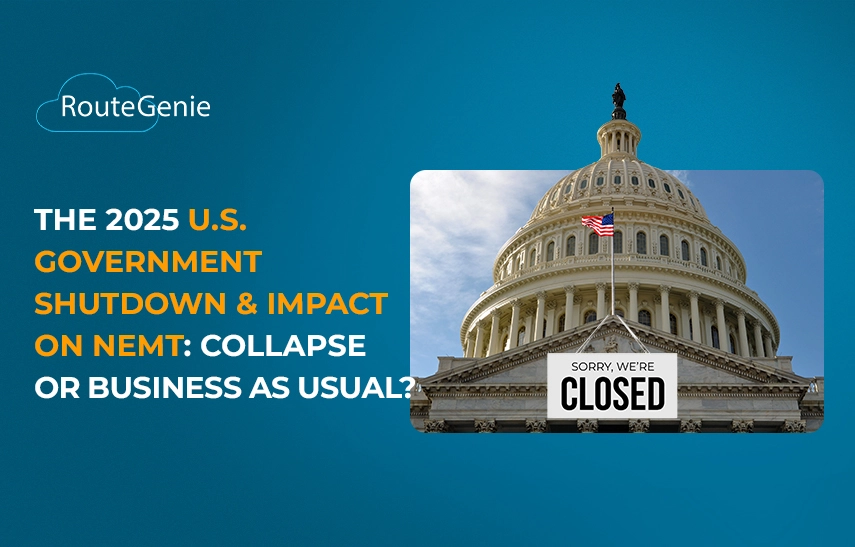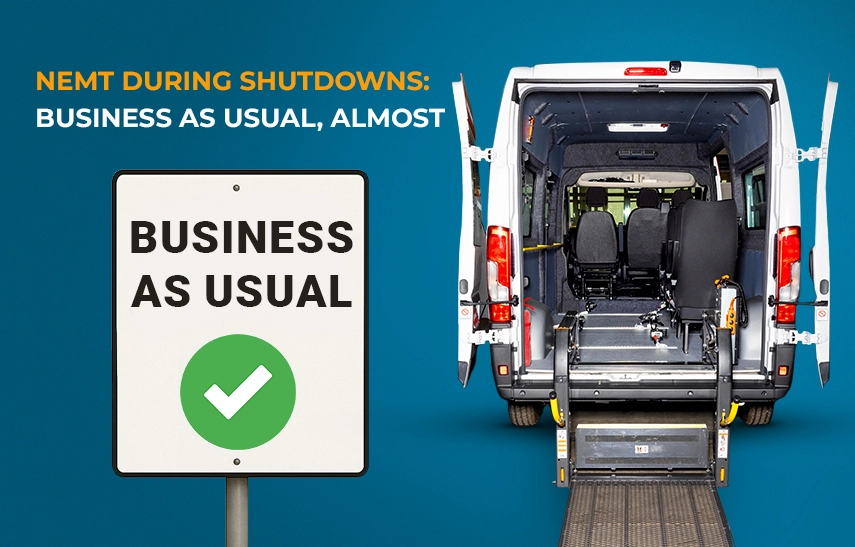The 2025 U.S. Government Shutdown & Impact on NEMT: Collapse or Business as Usual?

The headlines on October 1, 2025, shook the nation, announcing the U.S. government shutdown. After Congress failed to pass a stopgap spending bill, the federal funding lapsed, and the nation entered a period of uncertainty. At the moment, many “non-excepted” federal employees are furloughed, and some public-facing services are paused. Fortunately, essential functions like national security, law enforcement, and certain safety operations continue.
As a federal agency, the Centers for Medicare & Medicaid Services has also come under scrutiny. Only half of its workforce will continue to operate under the contingency plan. That raises an important question: what does this mean for non-emergency medical transportation, an essential Medicaid benefit that millions rely on to access care? Let’s clarify the consequences of the 2025 government shutdown for the NEMT industry, the impact on passengers, and how you can mitigate potential risks for your business.
Contents:
- Government Shutdown 101: What It Is, Why It Happens
- 2025 Shutdown At A Glance: Is This Time Different?
- Health Programs During a Shutdown: What Continues vs. What Slows
- NEMT During Shutdowns: Business as Usual, Almost
- How Long Could the 2025 Shutdown Last? What Does That Mean Operationally
- How to Prepare for a Long Shutdown
- Bottom line
Government Shutdown 101: What It Is, Why It Happens
The reason for a shutdown is a lapse in annual appropriations (or failure to pass a continuing resolution). Simply put, if Congress fails to agree on a budget that funds federal operations, government agencies must cease all non-essential operations until such an agreement is reached and funding is approved. This mechanism adheres to the legal requirement under the Antideficiency Act, which prohibits spending money without an appropriation from Congress. Lacking legal authority to obligate funds, government agencies are forced to implement contingency plans. These identify which functions are deemed as “excepted” (exempt from defunding) and can continue without appropriation.
Shutdowns have become increasingly common in recent decades and are attributed to the political impasses over budget priorities, policy that comes along with the funding bills, and the ever-present debate about the debt ceiling. The impact of shutdowns varies by agency and function; some operations must halt immediately, while others can continue if funded through mandatory spending or deemed essential to protecting life and property.
2025 Shutdown At A Glance: Is This Time Different?
 The 2025 government shutdown carries some unique characteristics. Unlike many of the previous funding lapses, this one began precisely at the start of the fiscal year, meaning no continuing resolution was passed to buy time for negotiations.
The 2025 government shutdown carries some unique characteristics. Unlike many of the previous funding lapses, this one began precisely at the start of the fiscal year, meaning no continuing resolution was passed to buy time for negotiations.
Unfortunately for the healthcare industry, it is a central flashpoint in this shutdown. Compared to some previous shutdowns, only 50% of CMS staff are designated as excepted employees, resulting in significant operational constraints for the agency.
Timing is critical. October coincides with the start of open enrollment, adding to the strain as states juggle budget cycles with fewer federal personnel. The post-pandemic healthcare landscape already puts pressure on NEMT and Medicaid, with higher demand, staff shortages, and changing telehealth policies. Meanwhile, today's Medicaid infrastructure is both more automated and more interconnected than during past shutdowns, which improves efficiency but adds vulnerabilities when federal support is withdrawn.
Health Programs During a Shutdown: What Continues vs. What Slows
Medicare and Medicaid are mandatory, so payments and coverage continue during a shutdown. Claims processing also benefits from automation, as it is classified as essential. This means the money continues to flow for services already rendered and pre-authorized.
The problem is administration. CMS operates with approximately half its staff, so provider applications, waiver amendments, audits, and policy guidance move much more slowly. Anything that requires human review piles up, and help desk support dwindles to emergency inquiries only.
Public health programs vary: appropriation-funded programs that are mandatory continue, but discretionary programs, such as research grants, prevention efforts, and some monitoring, may cease. Capitation payments for managed care continue unabated, but new contract approvals, rate reviews, and value-based arrangements often stall.
NEMT During Shutdowns: Business as Usual, Almost
 So, what is the situation within the medical transportation field during a government shutdown?
So, what is the situation within the medical transportation field during a government shutdown?
1. Normal operations continue
NEMT providers and brokers can expect day-to-day operations to run pretty much as normal during the shutdown, but there are a few things you need to watch out for. The good news: NEMT is a mandatory Medicaid benefit, and Medicaid funding doesn't stop during shutdowns. That means if you're already an established player, your day-to-day won't skip a beat. Trips get scheduled, patients arrive at their appointments, your claims get processed, and your payments arrive when they're due. All of the behind-the-scenes tech, like broker platforms, eligibility checks, and claims processing, keeps humming along on autopilot.
2. Delays in state–federal communication
However, let's discuss where things become complicated. When state agencies need answers from CMS, they will likely wait longer than usual. If your state was rolling out a new NEMT program or waiting on approval for changes that affect transportation, expect those to hit the pause button.
3. Enrollment and credentialing slowdowns
Also, if you are new to the game or expanding, do not expect expedited procedures. Provider enrollment and credentialing that need federal sign-off will move at a snail's pace. Applying for a new Medicaid provider number or entering a new state will require additional time. Re-enrollment could get messy, too, if the federal verification systems are running on a skeleton crew.
4. Passenger concerns and confusion
The shutdown won't directly impact your NEMT operations, but you'll likely feel the effects. Get ready for your phones to blow up with worried passengers asking if their Medicaid is still valid and if they can still get rides, even though nothing has actually changed for them.
5. Clinic and facility disruptions
Some clinics and doctors' offices might scale back their hours or squeeze their schedules because they're dealing with their own shutdown headaches, which could make your day-to-day planning a bit more chaotic.
6. Appointment cancellations due to economic strain
And here's something to keep an eye on: thousands of furloughed federal workers suddenly going without paychecks might start canceling appointments they can technically get to but can't afford to keep for other reasons.
How Long Could the 2025 Shutdown Last? What Does That Mean Operationally
Nobody knows how long this shutdown will last, but history gives us clues. We've had about 14 shutdowns since 1980; some wrapped up in days, others dragged on for 35 days, like that 2018-2019 marathon. Continue running your operations as usual, but tighten up your documentation and closely monitor your cash flow.
Short shutdowns (under two weeks) barely register: claims process, payments arrive, and you're just answering more anxious phone calls. Medium ones (two to four weeks) start creating friction as state agencies run out of workarounds and backlogs accumulate, though your money keeps flowing. Past a month? That's when things get messy. The 2018-2019 shutdown demonstrated that even when checks arrive, state-level chaos can become a significant problem.
How to Prepare for a Long Shutdown
 Your move?
Your move?
- Keep passengers informed so they know rides are still happening
- Stay tight with your state contacts and broker partners to catch issues early
- And build a cushion that can handle a 30-day payment delay, just in case
- Partner with a reliable NEMT software platform
Here's what most people miss: the shutdown ending might be tougher than the shutdown itself. When the government reopens, brace for a surge: provider applications, new policies, and audits will ramp back up quickly.
This is where solid NEMT software from RouteGenie can help you. While federal agencies struggle, your automated scheduling continues to run. Eligibility checks stay live through direct state connections. When you can't reach officials for answers, your software's compliance tools keep you audit-ready. Claims submit and track themselves without needing skeleton-crew agencies to babysit them.
Your software also keeps passengers calm with automated reminders and real-time tracking. It identifies trouble, such as unusual cancellation spikes and scheduling shifts, before they escalate. And when that post-shutdown wave hits, your cloud system keeps everything humming while others drown in backlog.
Bottom line
This shutdown creates anxiety, but your operations continue to run. Your services are essential, funding is solid, and passengers need you. Communicate effectively, stay compliant, leverage your technology, and prepare for the chaos when doors reopen. NEMT providers and brokers who stay disciplined through uncertainty come out stronger, and if you supercharge your business with reliable NEMT software, this period becomes even less daunting.
About the author

As RouteGenie's Marketing Director, Yurii gained deep knowledge in the NEMT industry. He is an expert in marketing, utilizing all marketing channels to build RouteGenie's brand and to make sure NEMT providers have access to powerful NEMT software that can boost their growth. Yurii shares his knowledge by writing content on topics related to marketing, and the healthcare industry: medical transportation, home care, and medical billing.
The author assumes no responsibility or liability for any errors or omissions in the content of this site. The information contained in this site is provided on an "as is" basis with no guarantees of completeness, accuracy, usefulness or timeliness.